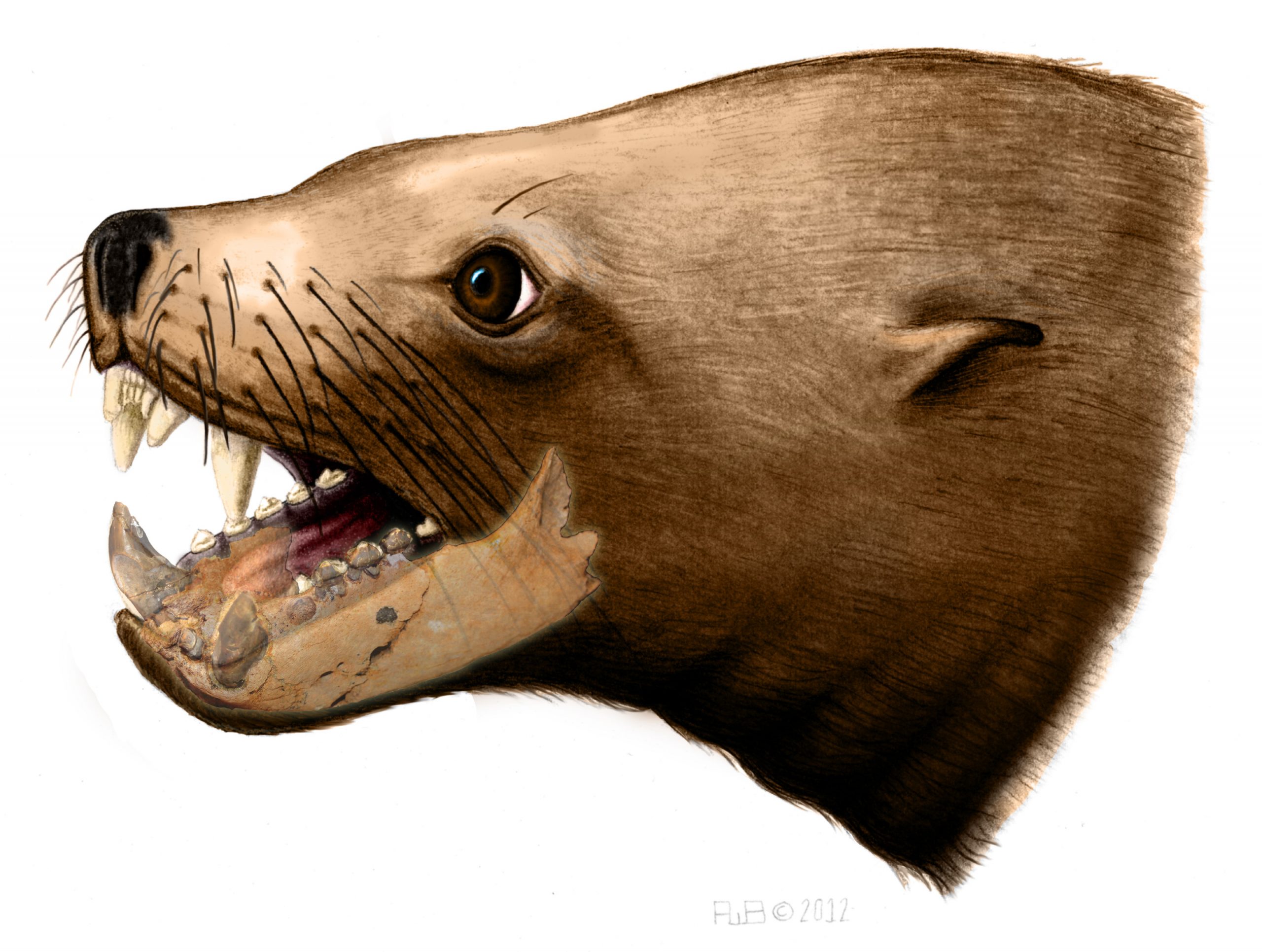New fossil suggests giant ‘killer walrus’ was just a toothy fish-eater
Sea lions, otters, humpback whales and harbor seals are familiar sights to most native Californians today, but the waters off this coastline once harbored a much stranger fauna: giant bony-toothed birds, sharks the size of whales, flightless penguin-like auks, sea cows and giant predatory sperm whales.
Several species of walruses also lived among these animals, but only one survived to the present-day. Robert Boessenecker, author of a paper published in PLOS ONE today, explains what one rare fossil of an extinct walrus reveals about life on Sharkstooth Hill about 15 million years ago:
How did you become interested in studying extinct walruses?
I was always interested in paleontology as a kid, but where I grew up in California, there aren’t any dinosaurs – so I went out collecting shark teeth in high school. As an undergraduate, my adviser encouraged me to start a field-based research project, so I began studying fossil sharks, birds, and marine mammals from the San Francisco region. This turned me on to marine mammal paleontology in general, and I started looking at fossil walruses from other areas in California and Oregon.
What was previously known about the extinct walrus Pelagiarctos?
Pelagiarctos, and close relatives – probably looked a bit more like a sea lion than the modern walrus, as they lacked long tusks.
The first fossils of Pelagiarctos included just the “chin” end of the jaw, and a handful of large teeth, and were discovered in the 1980’s at the famous Sharktooth Hill fossil site near Bakersfield, California. The jaw fragment is very large and the two jawbones were fused at the chin – like humans, but not typical for pinnipeds. The large teeth are somewhat similar to those of terrestrial “bone-cracking” carnivores like hyenas, and so Pelagiarctos was interpreted as an apex predator that was adapted to feed upon warm blooded prey, perhaps including smaller pinnipeds and marine birds, in addition to the typical pinniped diet of fish. The large size and fusion of the lower jaws also suggested that Pelagiarctos could produce a large bite force – also pointing towards it being an apex predator, or “killer walrus” if you will.
Lastly, fossils of Pelagiarctos are extremely rare. Although there are hundreds of specimens of other pinnipeds from Sharktooth Hill – there are only seven known specimens of Pelagiarctos from that site.
In your paper, you describe the discovery of a new jaw bone with teeth. What did this reveal about this walrus’ feeding habits?
The discovery of a more complete specimen allowed us to test the hypothesis that Pelagiarctos was a “killer walrus”. When we examined the new specimen and the original fossils, we found that the teeth really weren’t that sharp at all – in fact, the teeth looked like scaled up versions of the teeth of a much smaller sea lion. This told us that the tooth shape is really just a consequence of Pelagiarctos retaining primitive teeth, rather than being a feeding adaptation.
What about body size? My coauthor, Morgan Churchill, developed a method to reconstruct body size of fossil pinnipeds based on the size of the lower jaw. As mentioned already, Pelagiarctos was indeed large, about the size of large male sea lions. However, when you try to correlate the weight of modern pinnipeds with what they eat , there isn’t really any distinct trend. This is because most modern pinnipeds are generalists, and tend to eat fish, squid, and even krill and mollusks. Even the modern walrus, a mollusk specialist and an exception to the generalist ‘rule’ occasionally kills and eats marine birds and even other pinnipeds. The only pinniped to regularly hunt warm blooded prey – the leopard seal – spends a good deal of the year feeding on krill.
These alternative interpretations and observations – combined with the lack of feeding adaptations, suggests Pelagiarctos was also a generalist fish eater rather than a “killer walrus” that only hunted marine birds and warm blooded prey.
Does this tell us anything about the walruses that exist today?
This new find and reinterpretation of Pelagiarctos as a fish-eater gives us a slightly more accurate picture of the evolutionary background of the modern walrus. Right now, there is only one modern walrus species but back then, walruses were a very diverse group. Many of these other extinct walruses had strange adaptations – such as the development of upper and lower tusks, gigantic body size, ultradense bones, unusually short forelimbs, and even the loss of all teeth aside from tusks. The myriad types of extinct walruses – Pelagiarctos included – beautifully demonstrate the often convoluted path that evolution can take.
What is the most important aspect of your results?
Pelagiarctos lived roughly 15-18 million years ago; this period is also referred to as the “middle Miocene Climatic Optimum”, and global temperatures increased for a little while. After the optimum, the earth began to cool again.
Any information we can get that improves our knowledge of extinct marine mammal food webs – especially during times of climatic change – is a step forward towards putting together a “deep time” context for understanding modern marine mammal ecology.
Read more about this fossil at the author’s blog.
Image: Artist’s restoration of Pelagiarctos, Robert Boessenecker
Citation: Boessenecker RW, Churchill M (2013) A Reevaluation of the Morphology, Paleoecology, and Phylogenetic Relationships of the Enigmatic Walrus Pelagiarctos. PLoS ONE 8(1): e54311. doi:10.1371/journal.pone.0054311


